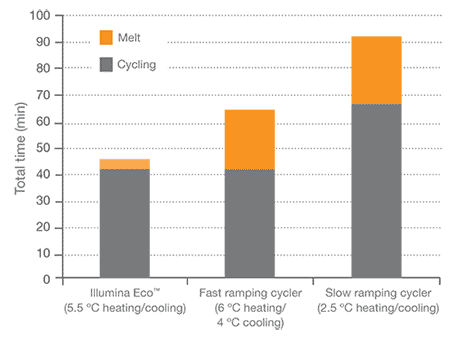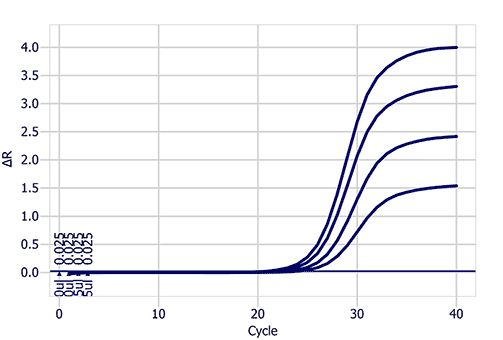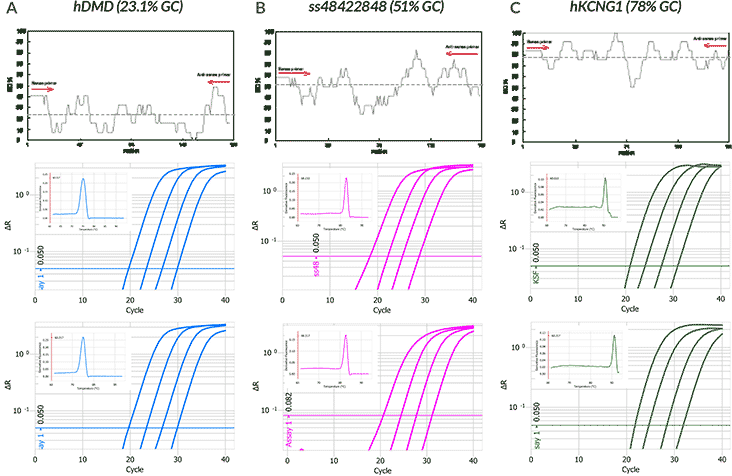Fast real-time PCR is a demanding application that requires consistent and reproducible results from the difficult amplicons and low-volume reactions.
The combination of the Illumina Eco™ Real-Time PCR System and KAPA SYBR® FAST qPCR Kits from Kapa Biosystems provides an industry-leading solution for low volume, fast real-time PCR without compromising reaction efficiency, specificity and reproducibility.
Introduction
The number of applications utilizing real-time PCR (qPCR) is expanding rapidly. The improved accuracy of results relative to end-point PCR, multiplexing capability, reduced risk of amplicon contamination, and streamlined time-to-results from closed-tube qPCR assays are factors contributing to the growth of real-time PCR. Common qPCR applications include: gene expression profiling, genotyping, copy number detection, validation of siRNA knockdown, miRNA assays, bacterial and viral load determination, ChIP qPCR, and next-generation sequencing library quantification.
The specificity and efficiency of qPCR depend upon precise temperature control during the denaturation and annealing steps. For the highest accuracy, the temperature must remain uniform across the entire heating block to ensure all samples are processed equally. Standard SYBR® Green I-based qPCR cycling protocols take between 1 hr to 2 hr, depending on the ramp rate and data acquisition times of the specific qPCR instrument used (Figure 1). Faster cycling protocols (~45 min) that do not compromise reaction efficiency typically require instrumentation with increased thermal ramp rates, uniform heating across the block, and specially formulated qPCR reagents.
The Illumina Eco™ Real-Time PCR System is based on a proprietary thermal system that enables highly uniform temperature control and fast ramp rates. To achieve accurate temperature control, the Eco™ thermal system incorporates a precisely electroformed hollow silver block that is heated and cooled by a single Peltier device. During PCR cycling, conductive fluid circulates rapidly throughout the hollow chamber, transferring heat from the Peltier device evenly across the entire block. This unique design virtually eliminates thermal non-uniformity and block edge effects, providing a new level of thermal performance of ± 0.1 °C well-to-well uniformity across a 48-well plate. The result is higher qPCR performance, including tighter replicates and improved reaction efficiency and specificity.
Wild-type Taq DNA polymerase is theoretically capable of a 30 sec combined annealing and extension time required for short qPCR amplicons. However, inhibition due to SYBR® Green I dye, steric hindrance from templates with high GC or AT content, and lower enzyme activity at 60 ºC can result in compromised reaction efficiencies or even reaction failure when fast qPCR cycling protocols are used in conjunction with reagents containing wild-type Taq DNA polymerase.
In contrast, the KAPA SYBR® FAST qPCR Kit contains a second-generation DNA polymerase with an intrinsic ability to synthesize DNA much faster than wild-type Taq DNA polymerase. The KAPA SYBR® DNA Polymerase was engineered via molecular evolution in the presence of elevated concentrations of SYBR® Green I dye, resulting in an enzyme that exhibits less SYBR® Green inhibition and a faster extension rate than wild-type Taq DNA polymerase. High signal strength, which is particularly useful when performing low-volume qPCR, is achieved by an increased concentration of SYBR® Green I dye in KAPA SYBR® FAST master mix. KAPA SYBR® FAST qPCR Kits are supplied with an antibody-based hot start, enabling a short initial activation hold time at 95 ºC. PCR protocols using KAPA SYBR® DNA Polymerase are primarily based on reduced extension times that allow for a significant reduction in PCR cycling time without the risk of compromising reaction performance.

Figure 1.Total qPCR run time of Illumina Eco™ Real-Time PCR system in comparison to instruments with slow and fast ramp rates.
The same fast qPCR cycling and melting protocol was run on all three instruments (40 cycles of 5 sec at 95 °C and 30 sec at 60 °C, 60 °C - 95 °C melt). The slow ramping thermocycler has an average ramp rate of 2.5 °C/sec while the fast ramping thermocycler has an average ramp rate of 6 °C/sec heating and 4 °C/sec cooling. The Illumina Eco™ Real-Time PCR instrument has an average ramp rate of 5.5 °C/sec. In addition, the Eco™ supports continuous data collection in a single channel during melt analysis, resulting in increased data points and considerably reduced melt run times.
PCR Reaction Setup and Cycling Conditions
Primers were designed using Beacon Designer™ 7 to amplify AT- and GC-rich regions on human genomic DNA (hgDNA). The hDMD primer set amplified a 76.9% AT-rich target amplicon; the ss48422848 primer set amplified a balanced AT/GC target amplicon (51%) while the hKCNG1 primer set amplified a 78% GC-rich target amplicon.
Amplification of these targets was performed using either a standard or fast cycling protocol in 10 μL reaction volumes. These reactions were set-up in 48-well Eco™ plates with optical Eco™ adhesive seals using the Illumina Eco™ Real-Time PCR System. The KAPA SYBR® FAST 10 μL reaction set-up is shown in Table 1.
1 Reaction volumes between 5 μL and 20 μL are recommended for the Illumina Eco™
1 The optimal annealing temperature (Ta) of each primer set varied. The Ta for the AT-rich and balanced amplicons was 60 ºC. The Ta for the GC-rich amplicon was 67 ºC.
1 The cycling denaturation time was extended to 15 sec for the GC-rich region.
2 The optimal annealing temperature (Ta) of each primer set varied. The Ta for the AT-rich and balanced amplicons was 60 ºC. The Ta for the GC-rich amplicon was 67 ºC
Effect of Reaction Volume on Total Fluorescence and Robustness
Reduced qPCR running costs, particularly in combination with increased throughput, are always desirable. KAPA SYBR® FAST qPCR Kit delivers high levels of fluorescence and consistent Cq values, even when used at extremely low reagent volumes. This is illustrated when four different reaction volumes (2.5 μL, 5 μL, 10 μL and 20 μL) were used to amplify ss48422848, a 150 bp target amplicon with a balanced AT/GC content, using a standard cycling protocol (Table 2). A 1X master mix containing KAPA SYBR® FAST Master Mix, primers and template was prepared and the reaction volumes mentioned were aliquoted into PCR wells in replicates of six. As the reaction volume was halved, the resulting Cq values reflected the expected 2-fold change in copy number even at the lowest reaction volume (20 μL = Cq 20.9, 10 μL = Cq 22.0, 5 μL = Cq 23.0, 2.5 μL = Cq 24.1).
A decrease in the reaction volume resulted in a lower background subtracted fluorescence. The lowest reaction volume still provided a robust signal due to the presence of a high concentration of SYBR® Green I dye in KAPA SYBR® FAST qPCR Master Mix (Figure 2).

Figure 2.Decrease in background subtracted fluorescence with a decrease in reaction volume
A uniform decrease in background subtracted fluorescence is obtained with a uniform decrease in volume. Consistent amplification and a robust signal is still obtained at 2.5 μL which is the lowest reaction volume recommended.
Effect of Different Cycling Protocols on Efficiency and Specificity Across a Range of AT- and GC-Rich Target Amplicons
To demonstrate the ability to perform fast qPCR cycling on AT and GC rich target amplicons, without compromising performance, a set of four 10-fold serial dilutions of hgDNA was amplified using either a standard or fast cycling protocol. The base pair distribution of each amplicon is displayed as a GC% plot (Figure 4, top row). The resulting log amplification plots and melt curves for reactions performed using the standard protocol and fast protocol (Figure 4, middle row and lower row respectively) indicate that both the specificity and efficiency of the qPCR reactions have not been compromised as a result of using fast cycling protocols relative to standard cycling protocols (for a description of each protocol Table 2 and 3).

Figure 3.Effect of Different Cycling Protocols
Conclusion
High-performance, fast qPCR on AT- and GC-rich targets requires a real-time instrument capable of extremely fast ramp rates with excellent temperature uniformity across all samples, and a qPCR reagent containing a DNA polymerase capable of synthesizing DNA significantly faster than wild-type Taq DNA polymerase. The combination of the Illumina Eco™ Real-Time PCR system and KAPA SYBR® FAST qPCR Kits provides an industry-leading solution for high-performance, fast qPCR without compromising reaction efficiency, specificity and reproducibility. In addition, the ability to perform low-volume qPCR can reduce running costs while maintaining high quality results.
To continue reading please sign in or create an account.
Don't Have An Account?